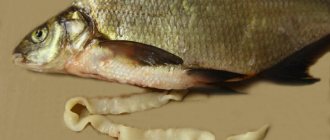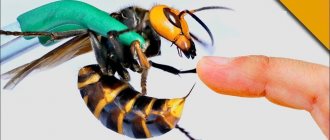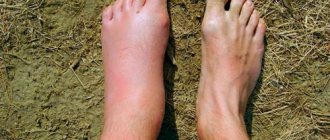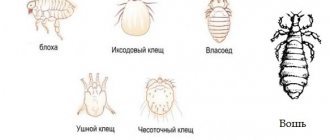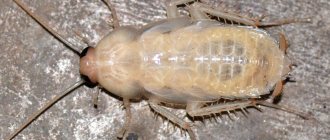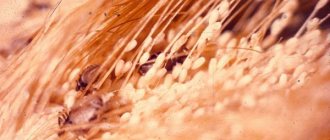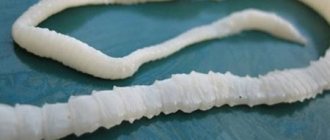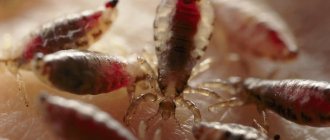Recently, the cuisines of many peoples of the world offer exotic fish dishes that do not undergo proper heat treatment. Raw, smoked or salted fish is found on the holiday tables of every second inhabitant of the planet, while few people think about how many dangers such food implies. Fish and meat carcasses are the most common sources of helminthiasis in humans, although many fish worms do not pose a danger to the human body. For example, red worms in fish are phylometra, which are safe for humans and only spoil the presentation of the fish.
What to do if you eat fish with worms?
The main rule for eliminating the danger in the presence of worms in fish is sufficient heat treatment of the food product during the cooking process. Even if there were any helminths, if prepared correctly, they were all neutralized. At temperatures of -25 degrees and below, fish are considered disinfected after 15 hours of frost treatment. In the case of salting, the helminths die within 10-14 days; dried fish are kept for at least 3 weeks.
If the fish was raw or undercooked, and worms were found inside, you need to consult a doctor and get tested. In addition, prophylactic use of anthelmintics would be appropriate. The carp family is considered the most dangerous fish species.
The larvae live in their body until the final host becomes infected with them.
In coastal and river areas, where fishing for many is the main way to provide food for their families, infection with worms occurs more often than in continental areas. This is due to the fact that the methods of procurement and preparation of meat practiced by the local population do not always provide for the correct heat treatment of seafood.
Worth knowing!
Among the worms that infect the inhabitants of aquatic spaces, the most dangerous are those species that in the larval phase have dimensions of 2..5 mm, which makes them invisible when cutting the product.
Sturgeon species do not pose a risk of helminth infection.
In the sea
The anisakid family belongs to the group of nematodes, that is, in terms of body shape they are roundworms. The length of adult individuals reaches 65 mm in females and 55 mm in males. The maximum size of the larvae is about 40 mm.
Important!
They can secretly live in a person for 7 or more years, causing great damage to health, commensurate with the harm caused by such dangerous helminths as opisthorchid.
Wide tapeworm
Helminth causes diphyllobothriasis
. The carrier of the wide tapeworm is freshwater (ruff, river perch, pike, salmon, burbot) and anadromous (living in salt and fresh water) fish.
The wide tapeworm can live in humans for up to 25 years, reaching a length of 12 meters. The incubation period is 2 months.
- Mechanical.
Attaching to the intestinal wall, it damages it, causing ulcerations. With massive invasion, intestinal obstruction is possible. - Nervous reflex.
Under its influence, the nerve endings of the intestinal wall are irritated, leading to dysfunction of the gastrointestinal tract. - Toxic-allergic, causing rashes on the body and itching.
- Reduces vitamin B12 levels, leading to anemia.
Plerocercoids
Diphyllobothrium dendriticum
For your information!
Once in the body, the larva of Diphyllobothrium dendriticum with dimensions of 5...8 mm grows into an adult about 1 m long. It is localized in the intestines, causing various gastrointestinal diseases.
Chinese fluke
Chinese fluke causes clonorchiasis
, manifested in the acute form by fever, allergic rashes, liver and lung damage. After 2-3 weeks, the acute form becomes chronic, which affects the bile ducts, stomach, duodenum, and pancreas. It is possible to develop pancreatitis and hepatitis, impaired motility of the gallbladder, and enlarged liver. If treatment is not timely, cirrhosis cannot be ruled out.
In the human body, the Chinese fluke can live up to 40 years.
Trematode metagonimus
The helminth causes the disease metagonimiasis,
manifested at an early stage by skin itching, fever, eosinophilia. A little later, gastric distress develops in the form of nausea and diarrhea.
Small larvae located under the scales and fatty tissue or in the fillet may not be noticed when cutting, so there is a great danger of eating them along with the prepared dish.
Trematode nanophyetus
This is a very small oval-shaped helminth measuring approximately 0.5×05 mm. Causes the disease nanophyetosis
, which manifests itself as allergic reactions and inflammation of the small intestines (enteritis), followed by atrophy of the intestinal wall. With massive infestation, abdominal pain, unstable stools, nausea, vomiting, and weight loss are possible. Humans are the definitive host for the trematode nanophyetus.
Red fish (trout, salmon, chum salmon, pink salmon) have always been valued as a gourmet product. Moreover, gourmets prefer half-baked or raw products subjected to minimal processing.
In their opinion, this preserves the taste and nutrients as much as possible.
And when infection with worms occurs, many are unaware of the real cause of the ailment, which manifests itself with symptoms characteristic of many other diseases - indigestion, allergic rashes, etc.
The causative agent of diphyllobothriasis is the broad tapeworm
. Most often, chum salmon and pink salmon become infected with it. Helminth larvae are found in capsules similar to grains of rice, which can be localized in the gastrointestinal tract, liver, milk, muscles, and caviar. If the capsule is destroyed, the milky larvae enter directly into the host's body. Their sizes can reach 55 mm in length and 3 mm in width.
When the larvae enter the main host, the helminth begins to grow, which can reach a length of 12 m. The broad tapeworm can live in the human body for up to 15 years, affecting organs and causing poisoning with toxins. The most typical manifestations of diphyllobothriasis are indigestion with nausea, vomiting, belching, heartburn and loss of appetite. Headache and allergic skin rash often occur.
Nanophyetosis
Anisakidosis
Helminthiasis is caused by anisacids
belonging to the class of nematodes. They resemble roundworms in shape, but are much smaller in size - up to 2.5 cm in length. The color is whitish, brown or cream.
Worth knowing!
A large number of sea fish are infected with anisakid larvae, including red salmon - pink salmon, trout, chum salmon, and salmon. They are localized in the liver, spleen, abdominal cavity, gastrointestinal tract, caviar, milk, but most often in fillet.
In humans, anisakids invade the walls of the gastrointestinal tract, which can result in the formation of ulcers.
Types of parasites
There are different types of parasites that are found in live fish. Moreover, there are those that pose a huge danger to the human body, and there are also safe ones.
Wide tapeworm
This is a rather dangerous parasite. If it enters the human body, it can cause a disease such as diphyllobothriasis. In the human body, this worm can grow up to several meters in length. Its body has the shape of a ribbon, consisting of a large number of segments. At the end of such a head part of the parasite is its head, on which there are two grooves. With the help of these grooves the worm is held on the surface of the internal organs. These rather large parasites can live not only inside humans, but also inside pets such as:
- Dogs.
- Cats.
- Pigs.
The larva of such a parasite is quite small, measuring 5x3 mm. The larva is distinguished by its white color and the soft structure of its tissues. In predatory fish species, such larvae can be found in muscle tissue.
In fish such as pike or burbot, the larvae are mainly located in the liver, as well as inside other viscera. The number of larvae is simply huge, from 3 to 10 thousand pieces.
If a person, without preliminary and high-quality heat treatment, eats infected fish, then within a couple of weeks such a small larva will grow into an adult worm. At the same time, it should be noted that a person will not feel anything even during this period, since the main signs of infection begin to appear only after six months. The first signs of infection appear:
- In the form of severe pain in the abdominal area.
- In the form of a nagging pain in the right hypochondrium.
- Weak appetite.
- In weakness of the whole body.
During this period, up to one and a half hundred adult tapeworm worms can be present in the human body, as they constantly reproduce. This can lead to the fact that a person begins to lose consciousness from time to time, as a consequence of the manifestation of malignant anemia. At the same time, not every organism is able to react negatively to the presence of parasites. Some people do not feel that there are helminths living in their body. Even scientists do not know why the reaction of some people to helminths that appear in their body can vary so much.
Cat fluke
This parasite has another name - the Siberian fluke. The helminth has a flat body shape and poses no less danger to people than the tapeworm. This parasite can only enter the human body through consumption of contaminated seafood.
On the flat body of this terrible parasite there is a pair of suckers, with the help of which the helminth is held on the walls of various organs. As a rule, they can be found not only in the intestines, but also in the human liver.
At the initial stage of development, fluke larvae are located in the body of the snail. At the next stage, this parasite leaves the snail's body and ends up in a body of water, where they enter the body of the fish. After a couple of months, they can already be found in the muscle tissue of the fish, in the form of tiny round capsules, in which the same tiny worms live. If a fluke enters the human body, it can parasitize for years, filling the body with its toxins. Similar parasites can be found in fish such as:
- Bream.
- Roach.
- Tench.
- Guster.
- Bleak.
- Ide.
- Chub.
- Carp and carp.
Fluke is dangerous because it is quite difficult to detect in the body of a fish, even with a very careful examination.
Once in the human body, the fluke quickly multiplies, parasitizing on internal organs. Infection with this parasite causes a person to:
- Immunity decreases.
- He feels sick all the time.
- I often have a headache.
- General apathy appears.
- Body temperature constantly rises for no apparent reason.
The presence of such symptoms is a signal to see a doctor, and you will have to conduct a full medical examination and tests. This is the only way to determine the presence of such parasites in the body.
Beltworm
While fishing, many fishermen could see fish swimming on the surface of the water and unable to escape into the water column. It’s unlikely that anyone would have thought that the reason for everything is the presence of the strap worm in the fish. This is a white worm that develops in the abdominal cavity of the fish. This parasite is popularly called a “tapeworm.” At the same time, the fish contains an immature individual that can lead to diseases such as ligulosis and digrammosis. From the fish, the tapeworm enters the abdominal cavity of birds that feed on fish. While in the abdominal cavity of the fish, the Ligulidae becomes a sexually mature worm, after which it is already possible to reproduce.
The following fish are susceptible to infection with this parasite:
- Bream.
- Guster.
- Rudd.
- Vobla.
When this worm enters the fish's stomach, it feeds on the fish's internal resources. As the parasite grows, the internal organs of the fish are compressed, which leads to disruption of their normal functioning. During the growth process, this parasite damages the swim bladder, which then cannot function.
It is very important, when you see such an individual, to catch it from the water so that the disease does not spread. If the fish is gutted and washed well, then after that it can be eaten without fear, although the taste of the fish will be at a low level. The thing is that this parasite did not allow the fish to fully grow and develop for a long time.
Schistocephamos and phylometra
Schistocephalos is a small worm that has some similarities to the tapeworm, but is somewhat smaller in size. This parasite can be found inside crucian carp or smelt. The maximum length of this worm is a couple of centimeters. This parasite poses no danger to humans. If the fish is affected by schistocephamos, then it can be consumed without fear for your health.
The gills of carp fish species are often affected by phylometer parasites, which are thin, white worms about 10 centimeters long. They parasitize both under the gills and under their scales, and dark dots can be seen on the surface of the scales.
Trienophorus nodulosus and Cystidicola pharionis
You can learn about these parasites that live in the body of the fish during the process of cutting the fish, or rather, its liver. The burbot, or more precisely, its liver, is most susceptible to such an invasion. Trienophorus nodulosus is found in the liver, in the form of small whitish balls in which small worms live, almost up to 8 centimeters long. After removing such parasites, the liver poses no danger to humans.
Parasites such as Cystidicol farionis live in the swim bladder of smelt. They are distinguished by their round body shape, but are not dangerous to humans. After cutting the fish, it can be eaten without fear of contamination. It is not a problem to find the same worms in the swim bladder of fish such as pike perch and perch.
Anisakid
This parasite poses a great danger to human health. This is a roundworm larva that can be found in the body of such fish as:
- Atlantic herring.
- Mackerel.
- Blue whiting.
- Pollock.
- Salaka.
- Cod.
Ananiosis affects residents of some Asian countries, where raw fish forms the basis of the diet. After several days, after anisakid larvae enter the human body, the process of negative consequences begins.
Appearing in the human gastrointestinal tract and gaining a foothold in the mucous membrane, these parasites cause a strong inflammatory process, accompanied by the occurrence of ulcers and tumors, as well as bleeding.
In fish tissues, these parasites are rolled into rings, which are covered with a transparent membrane. Such larvae can be either red or yellow. If such larvae are found in fish, you will have to stop eating it.
There are parasites that do not penetrate the internal organs or tissues of the fish, feeding on the blood and meat of the fish. Such parasites are absolutely safe for humans, since they are not carriers of dangerous diseases.
Parasites in freshly caught fish
Danger to humans
Sushi lovers, for example, should know that seafood products are also susceptible to helminthiasis, therefore, while enjoying this dish, it is quite possible to become infected with worms. Since sushi does not involve heat treatment, you should either refuse it or take care of the prevention of helminthiases.
Important
be able to determine the presence of worms in meat.
From this point of view, small-sized helminths pose an increased danger. In addition to proper cleaning, sufficient heat treatment is also very important.
How to protect yourself from parasite infection?
Having bought fish even in the most expensive store, you can never know 100% whether there are worms in it. Therefore, to avoid eating food contaminated with parasites, it is necessary to select and process fish correctly.
The following recommendations will help you enjoy deliciously cooked fish and avoid becoming infected with helminths:
- When purchasing, you need to carefully inspect the carcass; you should refuse fish with dark spots on the skin, loose meat, cloudy or missing eyes;
- during cleaning, you should pay special attention to the insides; most often the parasites are localized there;
- to destroy parasites and their eggs, the fish must be heat treated (cook for at least half an hour, fry for at least 20 minutes, bake whole for at least 40 minutes);
- in fish frozen at -20⁰С, parasites die after 2 days, at -4⁰С - within a month;
- When salting, you must use a concentrated salt solution and keep the fish in it for at least 15 days.
Well, of course, it all depends on the degree of infection. If your fish is infested with worms, the only thing to do is to get rid of it as soon as possible without any doubt.
Photos of helminths
There is a high probability of infection with helminthiasis when eating dishes prepared from sea fish affected by worms that have not undergone the necessary processing.
Tapeworms in pollock and sea bass
What do worms look like in pollock?
Helminths and their larvae in pollock are found on the inner surface of the abdominal cavity, viscera, and muscles. Among them are found:
Even having an idea of what worms look like in fish, it is not always possible to detect them visually. The presence of many types of helminths is detected only through laboratory tests.
Photos of what worms look like in Cod
Even fish, which is considered a delicacy, does not guarantee the absence of helminths. Poorly processed salmon, pink salmon, and chum salmon cause serious pathological processes in the body. Nematodes (roundworms) enter the human intestine in the stage of yellowish larvae. There can be up to a thousand worms in red fish. Fans of raw or lightly salted fish, sushi, and rolls are most at risk of becoming infected. Cod, beloved by many, is often affected by microscopic crustaceans, which, when decomposed, cause purulent processes.
What do worms look like in herring?
The larvae of the latter are the most dangerous. They can cause anisakiasis, a serious disease accompanied by severe complications.
Anisakidosis
- Nausea, vomiting.
- Stool disorders.
- Flatulence.
- Pain in the iliac region.
- Allergic rashes.
In some cases, anisakidosis is accompanied by fever, cough, and sore throat caused by the reflux of bile into the esophagus. Lack of timely treatment threatens intestinal obstruction and peritonitis. Staying in the human body for 3 weeks to 3 months, helminth larvae cause irreparable damage to human health. Knowing about the consequences of anisacidosis, the question of whether it is harmful to eat herring with worms is no longer worth it.
ANISAKIOSIS
0
The larvae of roundworms can infect almost all types of marine fish: cod, perch, salmon, etc. In particular, the prevalence of herring in the Baltic Sea is 30%, and in the North Sea - 55–100%. Anyone who enjoys Japanese dishes made from raw fish is at risk of getting sick. Anisakid larvae can provoke the development of intestinal ulcers; the incubation period is from 4–6 hours to 7 days. Manifestations: nausea, vomiting, abdominal pain, rash, fever, diarrhea.
Worms in river fish
What do worms look like in crucian carp and bream?
River fish are susceptible to infection by various types of helminths. Among them are representatives of nematodes, cestodes, and trematodes. The most common are flatworms. The most common helminth is the broad tapeworm.
But along with it, other species can enter the human body:
Representatives of the carp family are most often carriers of this disease. Penetrating into the human body when eating unprocessed fish, helminth larvae cause headaches, fever, and pain in the abdominal area. Prolonged course of the disease leads to liver cirrhosis and death.
Clonorchiasis
A disease caused by the Chinese fluke. It can occur in acute or chronic form. Characteristic symptoms are liver enlargement, yellowing of the skin, rash, nausea, diarrhea, muscle pain, fever. The biliary system and pancreas are affected. If left untreated, clonorchiasis can lead to complications such as liver abscess, cholelithiasis, and acute pancreatitis.
Metagonimiasis
It is caused by the smallest representative of flatworms, measuring no more than 2.5 mm. Symptoms of the disease are mild. For a long time (sometimes up to a year) a person may not be aware of the infection. An uncomplicated course is characterized by intestinal disorders that do not pose a serious health hazard. In severe cases, metagonimiasis can lead to brain damage. Like meat, raw fish can cause the development of enterobiasis, a disease caused by pinworms.
Diseases carried by infected fish
As a result of eating contaminated fish, a person can develop various diseases, such as:
- Diphyllobothriasis is a disease that is transmitted by certain parasites that live in the muscle tissue of some freshwater predatory fish. As a result of such an infection, a person experiences excessive salivation, the normal functioning of the digestive system is disrupted, and there is a weak appetite. In addition, a person may be in a depressed psycho-emotional state.
- Clinorchiasis is a disease that can be contracted by food products that have not undergone normal, high-quality heat treatment. The main carrier of the disease is the Chinese fluke, which can be found in the internal organs of fish belonging to the carp family. As a result of infection, a person is susceptible to general weakness, accompanied by an increase in body temperature. In addition, red spots may appear on the human body. If this disease is not diagnosed in a timely manner, serious problems with the functioning of the liver are possible.
- Ligulosis is a very common disease. You can become infected with this disease by eating cold-smoked bream or roach. The source of infection is tapeworm, which, when it enters the human body, negatively affects the functioning of the immune system, as well as all internal human organs.
- Nanophyetosis is a common disease that is typical for residents of the North and East of our country who eat salmon fish. The danger of the disease is that in the initial stages of the disease, it practically does not manifest itself at all. If detection is delayed, it may be too late, since the disease causes anemia. In these regions, as a preventive measure, it is necessary to undergo annual medical examinations for the presence of parasites.
- Opisthorchiasis is a disease caused by a parasite called the Siberian fluke, which can be found in the muscle tissue of fish species such as bream, carp and ide. At the initial stage of development of the disease, a person who has consumed contaminated fish experiences an increase in body temperature, frequent bouts of vomiting, and severe headaches. If the disease is not diagnosed at this stage, then further intoxication of the body leads to an increase in the size of the spleen and liver.
- Anisakidosis . You can become infected with this disease by eating raw sea fish that has not undergone special examination by sanitary services. The disease is accompanied by acute discomfort in the gastrointestinal tract, as well as the appearance of a rash on the skin.
- Metagonimiasis . This disease is transmitted by carp and salmon fish caught in fresh water bodies. This disease has almost the same symptoms as anisakiasis, so it is often impossible to make an accurate diagnosis.
When a person prefers to eat at sushi bars, he needs to urgently contact a specialist if any of the signs of infection appear. Early diagnosis eliminates the possibility of serious consequences for human health.
Is it possible to eat fish with worms?
What to do if you eat fish with worms?
Precautions: Proper Handling
Considering that almost all river fish are infected with helminthiasis, a person can only protect themselves from this disease by strictly following the rules for its preparation:
- You need to cook the fish for at least 20 minutes from the moment the water boils. A large carcass should be cut into pieces. Each side is fried for 10 minutes.
- Salting should be done in 2 kg portions. The safest fish is kept in the cold for 20 days in a strong salt solution.
- Worms in frozen fish are completely destroyed. In order to prevent helminths, freezing it in the freezer should be carried out for at least two weeks.
- The unpleasant smell of meat is one of the sure signs that there is an infection;
- The scales come off the skin easily;
- There is a mucous film on the skin and eyes;
- The gills have an unpleasant swampy tint;
These signs are characteristic symptoms of helminth damage. Therefore, it is better to refuse to eat such a product.
How to avoid infection
Is it possible to eat fish infected with tapeworm? Of course, if helminths are found in a product, it is best to refuse its use. If you decide to cook such fish, it needs to be well boiled or fried.
- You need to fry for at least 20 minutes at a temperature of about +60 degrees.
- It should be frozen at a temperature of -18 degrees for about two days.
- In dried fish, tapeworm in the form of an adult cannot exist and dies immediately, but in the form of eggs the probability of being found is high.
- There may be helminths in a smoked product if the procedure was quick and took place at an insufficiently high temperature.
- If the fish has been selected for salting, it must be salted for at least two weeks.
- Before buying, you need to feel the fish - the belly should not be swollen.
- It is best to take a whole carcass, not gutted - this way you can better see whether it is infected or not.
- It is better to fish in well-known artificial reservoirs.
- Do not give raw fish containing tapeworm to domestic or outdoor animals.
- After cutting a low-quality product, the board and knife should be washed with disinfectant detergents and doused with boiling water.
If infection occurs, anthelmintic drugs with a wide spectrum of action are prescribed - Albendazole, Mebendazole, Piperazine, Fenasal, Biltricide. Antispasmodics and painkillers, as well as antihistamines, may be required as auxiliary therapy.
At the same time, traditional medicine can be used. Products based on pumpkin seeds, garlic, onions, tansy, wormwood and other natural ingredients are very popular.
The entire period of treatment and recovery must adhere to a special diet. Fatty, spicy, salty foods should be excluded from the diet. It is not recommended to eat eggs and dairy products. Carbonated drinks and alcohol are excluded. Preference should be given to vegetables and fruits.
To fully restore the body, other groups of medications may be required - drugs that improve intestinal microflora and motility, hepatoprotectors, immunomodulators, vitamins and minerals. If signs of anemia appear, then B12 vitamins and preparations containing iron are prescribed.
In order not to risk your health, it is best to throw contaminated fish into the garbage chute, wrapped in paper and a plastic bag. But even if the fish was contaminated, if sanitary and hygienic standards are observed, health problems should not arise.
Diplostomiasis
Diplostomiasis is quite common in fish living in fresh or slightly salted water. The disease is caused by a trematode larva. Birds are considered the final host. Penetrating inside the body, the worms lay their eggs in the fish. Together with bird feces, they end up in water bodies, where they find a temporary host for maturation - mollusks. Having reached the required stage of development, the tapeworm leaves the body of the mollusk and infects the fish. The worm enters the body of a marine inhabitant through the skin or through the eyes. It can live inside for up to several years, developing into metacercariae. This causes damage to the eye and blindness. When infected waterfowl enters a bird's food supply, the infection process begins in cycles. For humans, this type of helminth is considered not dangerous.
Worms (helminths, helminthiasis) in fish, dangerous to humans
Recently, the problem of helminthiases has become very widespread.
According to WHO, more than 15 million people become infected with worms every year. Eating fish is especially dangerous in terms of helminth infestation. The population consumes raw fish en masse, as Japanese cuisine has now become very popular. Parasites are found in species that live in both river and sea salt water. Almost all fish found in fresh water are infected with helminths. Of particular note is the carp family. These include roach, bream, roach, etc. – species in which worm eggs are most often found. The photo shows helminths in fish.
Which marine fish have helminths? Worms can be found in mackerel, hake, horse mackerel, cod and many others. Are there worms in salted or smoked fish? Yes, this is a common occurrence today. Sometimes you can find parasites in canned fish. This occurs due to poor quality control of products, improper preparation or violation of storage conditions.
In both river and sea species, helminths of various classes are found, which include:
- roundworms;
- flukes;
- tapeworms.
The most common diseases are: opisthorchiasis, diphyllobothriasis, clonorchiasis, nanophyetosis, metagonimiasis, anisakiasis, ligulosis.
The most dangerous for humans is the tapeworm in fish, which can reach 15 meters.
Can you get worms from fish? Yes, sure. However, helminths do not have such a negative effect on fish, since they are only a temporary host, and humans are the final host.
Worms in fish - can you eat it?
What to do if there are worms in fish meat (as in the photo)?
It all depends on the type of product and the method of its preparation. It is known that fish worms die at temperatures below 25 degrees and above 100 degrees. That is, if the product was either frozen or heat-treated, it becomes suitable for consumption. Rules for heat treatment of fish: boil for at least 30 minutes, fry for at least 20 (if the fish is large, you must first cut it along the spine or into smaller pieces), bake for at least 40 minutes.
At temperatures below 25 degrees, the product is disinfected within 15 hours. Helminth larvae die during salting after 10-14 days. It is recommended to dry fish for at least 3 weeks.
At the moment, sushi is widely used, for the preparation of which raw fillet is used.
What happens if you eat fish with worms? If helminths were in the meat of frozen fish or in one that was subjected to proper heat treatment, then there is no reason to worry. If the fish is raw or the cooking rules have been violated, it is necessary to urgently take measures to prevent helminth infection.
Symptoms of worms from fish
The first clinical manifestations of infection do not appear immediately. It all depends on the incubation period of helminthiasis, the time frame of which can range from a couple of days to several months (for example, with diphyllobothriasis, the incubation period can be 60 days). General signs:
- lethargy, drowsiness;
- fatigue under light loads;
- mood swings;
- body temperature up to 38 degrees;
- rash accompanied by itching;
- nausea, which may result in vomiting;
- diarrhea or constipation;
- bloating;
- weight shift;
- nervous breakdowns.
Only a few manifestations can be observed at the same time. It is worth noting the clinical picture of the most common helminth infections from fish:
- Opisthorchiasis. The asymptomatic interval lasts 2-4 weeks. Main manifestations: headache, fatigue, arthralgia and myalgia, cough, asthmatic suffocation, high body temperature (39-40 degrees), skin rash, yellow sclera, enlarged liver and spleen. It is necessary to seek medical help for opisthorchiasis urgently, as there are frequent complications that require urgent surgery;
- Diphyllobothriasis. The period without symptoms is 30-60 days. Manifestations: asthenovegetative syndrome, temperature not higher than 38 degrees, but sometimes can reach febrile levels, abdominal pain, nausea, diarrhea or constipation. Rich red spots appear on the tongue;
- Clonorchiasis. The reproduction time of the parasite without manifestations is 14-30 days. Clinic: characteristically acute onset, temperature 38-39 degrees, skin rashes, myalgia, arthralgia, sclera and yellow skin, hepatosplenomegaly, pain in the right hypochondrium, diarrhea, bloating;
- Nanophyetosis. The incubation period is 1-3 weeks. Signs: weight loss quickly, white skin with a bluish tint, pale mucous membranes, poor health, dizziness, stomach pain. A bowel disorder appears in the form of diarrhea or constipation. A characteristic feature is the occurrence of nausea and drooling mainly at night;
- Anisakiasis. The period of reproduction and spread of the parasite throughout the body ranges from several hours to two weeks. Signs: severe headache, temperature rises to 38 degrees, the patient feels nauseous, vomits after a while, sometimes even blood, distinct pain in the abdomen. A characteristic symptom is an allergy from a small rash to Quincke's edema;
- Metagonimiasis. The period without manifestations is up to 10 days. The disease begins with the appearance of a rash on the body without fever. After this, signs of damage to the gastrointestinal tract appear: loss of appetite, nausea, stomach pain, diarrhea.
What to do if you eat fish with worms?
It is necessary to immediately consult a doctor for medical help for timely diagnosis and early treatment.
This is due to the fact that there are types of helminths that can cause a number of complications, which in the future can lead to surgical interventions, and in particularly severe or advanced cases, to death. Therefore, if a helminthic infestation is detected in fish, it is better to get rid of it immediately and not risk your health. Examination of the whole family is mandatory, since many fish worms can be transmitted by contact. In addition, in children and some adults, parasites often do not give any clinical manifestations. So sometimes you may not even suspect that a person has worms. For control, it is necessary to take a stool test for worm eggs, and this test must be repeated several times at intervals of a week. But even after this, it is not always possible to identify traces of the presence of worms. Therefore, many doctors recommend preventive use of anthelmintic drugs twice a year.
To avoid re-infection, an important condition during treatment is mandatory hygiene and a therapeutic diet.
If you eat fish meat in which worms were found (pictured) or if any signs of helminthic infestation appear, you should not begin self-medication, but should immediately seek medical help. Firstly, in such a situation, the course of the disease can be started due to the wrong choice of drug. Secondly, many anthelmintic drugs are toxic, so treatment may not only not get rid of worms, but also harm your body.
Also, you should not immediately lean towards drug therapy, since there are many folk remedies that are suitable for treating both adults and children.
zhkt.guru>
Clonorchiasis
The Chinese fluke is the causative agent of the disease clonorchiasis. The main region of the disease is East Asia; in other areas, cases of infection are much less common. The intermediate host of the helminth is mainly the carp family, less commonly goby species, herring and shrimp. Once inside a person along with contaminated meat, the tapeworm can live in the body for up to 40 years.
Complications that clonorchiasis can cause have severe forms: stomach and pancreatic cancer, chronic hepatitis, peptic ulcers of the gastrointestinal tract. Anthelmintic drugs are used to treat the disease. Treatment is also prescribed depending on the symptoms: immunoboosting drugs, antispasmodics, sorbents.
The most susceptible fish species to infection
Although any fish can be infected with worms, some species are more susceptible to infestation. For example, parasites are found much more often in river and lake fish. The varieties most susceptible to parasite infestation include:
- crucian carp;
- perch;
- ide;
- bream;
- tench;
- pollock;
- flounder.
Depending on the type of parasite, fish may contain eggs, larvae, or adults. Preparing dishes from fish, which is likely to be contaminated, requires particularly careful cleaning and high-quality heat treatment.
Frequently asked questions and answers
Are there worms in sea fish?
In which bodies of water is there a high risk of fish becoming infected with worms?
Clonorchiasis is caused by flukes that are 10-20 mm long. Mature worms settle in the human body in the gallbladder and ducts or pancreas. are carps and crayfish such as calanus. A person becomes infected with clonorchiasis by eating uncooked fish or crayfish. Helminths can live in the body for up to 40 years. The disease is manifested by fever, allergic rashes and an increase in liver size.
Which fish doesn't have worms?
It is difficult to say for sure which fish are free of parasites, since absolutely all species are susceptible to infection. But there are some categories in which worms are very rare. These include species that live in the open seas or ocean, as well as fish that live in cold waters. Parasites are least often found in the following types of fish:
- sturgeon;
- tuna;
- mackerel;
- catfish
Tuna
You must understand that there are no guarantees and any individual can be infected, regardless of species.
Suppliers of artificially grown fish assure the absolute purity of their products. But whether artificial cultivation guarantees the absence of parasites and how carefully all sanitary conditions are observed in each specific farm is impossible to say for sure.
Signs of infection
It is also worth paying attention to the fish seller. A sloppy appearance and dirty hands should alert the buyer. Sanitary books are filled out even without the presence of the owners. Therefore, you need to be very careful and it is best not to buy fish from your hands.
No fish is completely safe; worms can affect any fish, regardless of species, size, age and habitat.
Sushi lovers need to know that helminths can also be found in sea fish. Since the classic Japanese dish does not require heat treatment during preparation, there is a high risk of contracting the disease. Eating this product should be done with caution.
What do helminths look like in fish?
Worms that can develop in fish belong to different species, therefore they differ in size, color, and location. It is not always possible to see worms, since sometimes their size reaches only a few millimeters, and they are located in the internal organs, muscles, and gills. The most difficult thing to notice with the naked eye is the larvae, but it is they who pose the greatest danger to humans. Adult helminths most often curl into a spiral or ring.
In order to make sure of the presence of worms, when cutting fish, you need to carefully examine it. But it is not necessary to find the parasites themselves. It is enough to know what fish infected with worms looks like. Most often, the surface of her body is uneven, with bumps and swelling. The color is uneven, with darkening, the eyes are cloudy.
Diagnostics and treatment measures
Very often such diseases are confused with various disorders of the gastrointestinal tract, hepatitis, and pneumonia. Due to the variety of symptoms, doctors can make an incorrect diagnosis, thereby prescribing the wrong treatment, which not only will not help overcome the disease, but will also aggravate the patient’s condition.
Among the folk remedies, laxative herbs help in the fight against worms: decoctions of elecampane and celandine. Another good way is to eat carrots, pomegranates, garlic, and walnuts. Pumpkin seeds are an excellent anthelmintic. It cannot be said that these recipes will defeat the disease, but they can be used as preventive measures.
Fish is not only tasty meat, but also a source of beneficial minerals and nutrients that humans need. But it is important to understand how dangerous it is to eat raw fish. Whatever method you choose when processing meat - heat, smoking or salting - remember the rules of hygiene. Take care of your health and the health of your loved ones.
How to distinguish infected fish?
There are times when worms in fish are easy to detect. During cutting, mature individuals or large larvae are visible to the naked eye. In such situations, there is no doubt that the fish is infected.
It is important to be able to distinguish normal fish from infected ones.
The appearance of the fish may indicate helminth infestation. If there are black spots on its surface, then this is a clear sign of infection. This description is especially typical for herring.
To identify contaminated fish, it is important to thoroughly inspect it before preparing and consuming it. You need to make sure that the internal organs and gills are clean and free of worms. Also pay attention to the fabrics.
Fishermen may also suspect that parasites live in fish while fishing. Such individuals have a special behavior - they float on the surface of the water, are lethargic, and also have a swollen belly. When you press on the belly of such a fish, a worm may appear.
Fish with parasites can often be identified during fishing
If you find infected fish in a pond, you should not release it back. It is better to bury such an individual in a place where animals cannot reach.
What could be the consequences?
The consequences after eating fish infected with worms can be not just sad, but also tragic. It is naive to think that worms live only in the intestines and do not cause much harm. These parasites penetrate all human organs, leading to a variety of consequences.
Larvae and adults are found in the lungs, brain, liver, and heart. The movement of larvae through the bloodstream is especially dangerous. Worm infestations can be fatal. Unfortunately, these cases are not isolated. The biggest danger is that helminths can live in the human body for years.
Poison the body for years without revealing yourself. Poor health, fatigue, decreased immunity is just the surface of the iceberg. Worms such as the broad tapeworm grow up to tens of meters. Twisting in the intestine, they block its lumen, and intestinal obstruction occurs. In this case, only surgical intervention can save life.
Another type of worm, such as the Chinese fluke, has suckers and uses them to cling to the intestinal walls. This often leads to deformation of nerve endings, and as a result, necrosis. It is not easy to destroy them in the body.
When they die, they release toxins, which also lead to serious complications. Therefore, in addition to deworming, it is necessary to take medications that will help remove dead worms from the body.
Don't self-medicate! Only a doctor, based on tests, will prescribe a treatment regimen with anthelmintic drugs!
What are these worms and what do they look like?
The table lists the worms found in fish that pose a great danger to humans.
| Name of worms | Appearance | Diseases they cause |
| Anisakids | Roundworms are 55 - 65 mm long with a body pointed on both sides. The larvae that are in the capsule and move freely are dangerous for humans. | Anisakidosis |
| Diphyllobothrium (Broad tapeworm) | A tapeworm with a length of 10 to 20 m. The body consists of 3 parts: head, neck and segments containing genitals. There can be more than 3000 of these segments. | Diphyllobothriasis |
| Clonorchis (Chinese fluke) | A flatworm, 10 to 20 mm long, belongs to the group of trematodes (liver flukes). It has a dark red translucent oval shaped body. | Clonorchiasis |
| Opisthorchi (Siberian fluke) (Cat fluke) | Flatworm 18 mm long, up to 2 mm wide. In the upper part there are two suction cups, with the help of which it is attached to the organs; the uterus with eggs is located in the middle part. | Opisthorchiasis |

